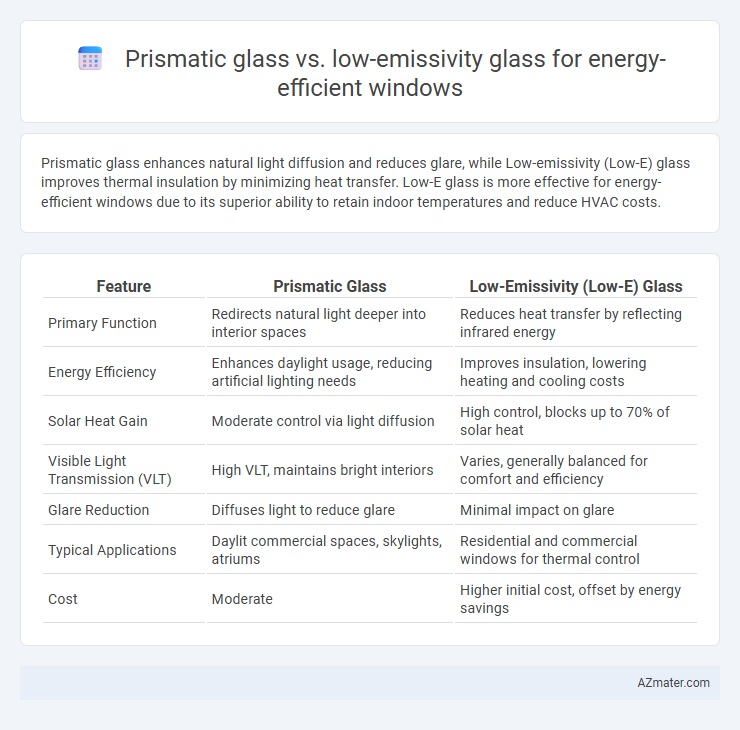Prismatic glass enhances natural light diffusion and reduces glare, while Low-emissivity (Low-E) glass improves thermal insulation by minimizing heat transfer. Low-E glass is more effective for energy-efficient windows due to its superior ability to retain indoor temperatures and reduce HVAC costs.
Table of Comparison
| Feature | Prismatic Glass | Low-Emissivity (Low-E) Glass |
|---|---|---|
| Primary Function | Redirects natural light deeper into interior spaces | Reduces heat transfer by reflecting infrared energy |
| Energy Efficiency | Enhances daylight usage, reducing artificial lighting needs | Improves insulation, lowering heating and cooling costs |
| Solar Heat Gain | Moderate control via light diffusion | High control, blocks up to 70% of solar heat |
| Visible Light Transmission (VLT) | High VLT, maintains bright interiors | Varies, generally balanced for comfort and efficiency |
| Glare Reduction | Diffuses light to reduce glare | Minimal impact on glare |
| Typical Applications | Daylit commercial spaces, skylights, atriums | Residential and commercial windows for thermal control |
| Cost | Moderate | Higher initial cost, offset by energy savings |
Introduction to Energy-Efficient Windows
Energy-efficient windows utilize advanced glazing technologies like prismatic glass and low-emissivity (Low-E) glass to minimize heat transfer and enhance indoor comfort. Prismatic glass redirects sunlight deeper into rooms, reducing the need for artificial lighting, while Low-E glass features microscopically thin metallic coatings that reflect infrared heat, thereby improving insulation and reducing energy costs. Both glass types contribute significantly to lowering heating and cooling loads, optimizing building energy performance.
What is Prismatic Glass?
Prismatic glass enhances natural light diffusion by redirecting sunlight deeper into interiors through micro-structured patterns, reducing glare and improving daylight distribution. It supports energy-efficient windows by minimizing reliance on artificial lighting, thereby lowering energy consumption. Unlike low-emissivity glass, which primarily reduces heat transfer with a thin metallic coating, prismatic glass optimizes light management for enhanced indoor illumination and comfort.
What is Low-Emissivity (Low-E) Glass?
Low-Emissivity (Low-E) glass features a microscopically thin metallic coating that reflects infrared energy while allowing visible light to pass through, significantly reducing heat transfer. This coating improves energy efficiency by keeping interiors warmer in winter and cooler in summer, minimizing reliance on heating and cooling systems. Low-E glass enhances window performance by lowering U-factor values and solar heat gain coefficient (SHGC), making it ideal for energy-efficient building designs.
Energy Efficiency Benefits of Prismatic Glass
Prismatic glass enhances energy efficiency by diffusing natural light deeper into interior spaces, reducing reliance on artificial lighting and lowering electricity consumption. Its micro-structured surface redirects sunlight to minimize glare and heat gain, contributing to improved thermal comfort and decreased HVAC loads. Compared to low-emissivity glass, prismatic glass optimizes daylight utilization while maintaining effective solar heat control, making it a valuable option for sustainable building design.
Energy Performance of Low-E Glass
Low-emissivity (Low-E) glass significantly enhances energy efficiency in windows by minimizing infrared and ultraviolet light transmission without compromising visible light. Its microscopically thin metallic coating reflects thermal energy back into the room during winter and blocks external heat during summer, optimizing indoor temperature regulation. Compared to prismatic glass, Low-E glass offers superior thermal insulation and reduced energy costs, making it the preferred choice for energy-efficient window applications.
Heat and Light Transmission: Prismatic vs Low-E Glass
Prismatic glass utilizes micro-structured surfaces to refract and redirect natural light, enhancing daylight distribution while reducing glare without significantly impacting heat transfer. Low-emissivity (Low-E) glass features a microscopically thin metal oxide coating that reflects infrared heat, minimizing heat loss in winter and heat gain in summer while allowing most visible light to pass through. For energy-efficient windows, Low-E glass offers superior thermal insulation by reducing heat transmission, whereas prismatic glass excels in optimizing natural light distribution but does not provide significant thermal resistance.
Cost Considerations and Installation
Prismatic glass generally has a lower upfront cost compared to low-emissivity (Low-E) glass, making it a more budget-friendly option for energy-efficient windows. Installation costs for prismatic glass are typically similar to standard glass, while Low-E glass may require specialized handling to maintain its coating integrity, potentially increasing labor expenses. Choosing between the two depends on balancing initial investment against long-term energy savings and durability.
Durability and Maintenance Comparison
Prismatic glass offers enhanced durability with its textured surface that resists scratches and reduces the need for frequent cleaning, making it ideal for energy-efficient windows in high-traffic or exposed areas. Low-emissivity (Low-E) glass features a thin metallic coating that significantly lowers heat transfer but requires careful maintenance to avoid damage to the coating, which can degrade insulation performance if scratched or improperly cleaned. While both types contribute to energy efficiency, prismatic glass generally demands less maintenance and offers greater long-term durability compared to the more delicate Low-E glass.
Best Applications for Each Glass Type
Prismatic glass excels in optimizing natural daylight by diffusing sunlight evenly, making it ideal for spaces requiring uniform illumination without glare, such as offices and atriums. Low-emissivity (Low-E) glass is best suited for residential and commercial windows in climates with extreme temperatures, as it minimizes heat transfer and enhances thermal insulation to reduce energy costs. Combining prismatic glass in upper window sections with Low-E glass on lower panes can maximize daylight control and energy efficiency in mixed-use buildings.
Choosing the Right Glass for Energy Efficiency
Choosing prismatic glass for energy-efficient windows enhances natural daylight distribution, reducing the need for artificial lighting and lowering electricity consumption. Low-emissivity (Low-E) glass significantly improves insulation by reflecting infrared heat, maintaining indoor temperature and decreasing heating and cooling costs. Combining prismatic and Low-E glass technologies optimizes both light management and thermal performance, maximizing overall energy savings in residential and commercial buildings.

Infographic: Prismatic glass vs Low-emissivity glass for Energy-efficient window
 azmater.com
azmater.com